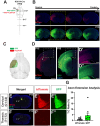This is a preprint.
Selective Targeting of a Defined Subpopulation of Corticospinal Neurons using a Novel Klhl14-Cre Mouse Line Enables Molecular and Anatomical Investigations through Development into Maturity
- PMID: 39713479
- PMCID: PMC11661177
- DOI: 10.1101/2024.12.10.627648
Selective Targeting of a Defined Subpopulation of Corticospinal Neurons using a Novel Klhl14-Cre Mouse Line Enables Molecular and Anatomical Investigations through Development into Maturity
Update in
-
Selective Targeting of a Defined Subpopulation of Corticospinal Neurons using a Novel Klhl14-Cre Mouse Line Enables Molecular and Anatomical Investigations through Development into Maturity.eNeuro. 2025 Aug 19:ENEURO.0589-24.2025. doi: 10.1523/ENEURO.0589-24.2025. Online ahead of print. eNeuro. 2025. PMID: 40829942
Abstract
The corticospinal tract (CST) facilitates skilled, precise movements, which necessitates that subcerebral projection neurons (SCPN) establish segmentally specific connectivity with brainstem and spinal circuits. Developmental molecular delineation enables prospective identification of corticospinal neurons (CSN) projecting to thoraco-lumbar spinal segments; however, it remains unclear whether other SCPN subpopulations in developing sensorimotor cortex can be prospectively identified in this manner. Such molecular tools could enable investigations of SCPN circuitry with precision and specificity. During development, Kelch-like 14 (Klhl14) is specifically expressed by a specific SCPN subpopulation, CSNBC-lat, that reside in lateral sensorimotor cortex with axonal projections exclusively to bulbar-cervical targets. In this study, we generated Klhl14-T2A-Cre knock-in mice to investigate SCPN that are Klhl14+ during development into maturity. Using conditional anterograde and retrograde labeling, we find that Klhl14-Cre is specifically expressed by CSNBC-lat only at specific developmental time points. We establish conditional viral labeling in Klhl14-T2A-Cre mice as a new approach to reliably investigate CSNBC-lat axon targeting and confirm that this identifies known molecular regulators of CSN axon targeting. Therefore, Klhl14-T2A-Cre mice can be used as a novel tool for identifying molecular regulators of CST axon guidance in a relatively high-throughput manner in vivo. Finally, we demonstrate that intersectional viral labeling enables precise targeting of only Klhl14-Cre+ CSNBC-lat in the adult central nervous system. Together, our results establish that developmental molecular delineation of SCPN subpopulations can be used to selectively and specifically investigate their development, as well as anatomical and functional organization into maturity.
Keywords: Brainstem innervation; Cerebellin; Corticospinal; Crim1; Easi-CRISPR; conditional AAV labeling; genomic Cre reporters; segmental axon projection.
Figures






Similar articles
-
Selective Targeting of a Defined Subpopulation of Corticospinal Neurons using a Novel Klhl14-Cre Mouse Line Enables Molecular and Anatomical Investigations through Development into Maturity.eNeuro. 2025 Aug 19:ENEURO.0589-24.2025. doi: 10.1523/ENEURO.0589-24.2025. Online ahead of print. eNeuro. 2025. PMID: 40829942
-
Cbln1 Directs Axon Targeting by Corticospinal Neurons Specifically toward Thoraco-Lumbar Spinal Cord.J Neurosci. 2023 Mar 15;43(11):1871-1887. doi: 10.1523/JNEUROSCI.0710-22.2023. Epub 2023 Feb 23. J Neurosci. 2023. PMID: 36823038 Free PMC article.
-
Prescription of Controlled Substances: Benefits and Risks.2025 Jul 6. In: StatPearls [Internet]. Treasure Island (FL): StatPearls Publishing; 2025 Jan–. 2025 Jul 6. In: StatPearls [Internet]. Treasure Island (FL): StatPearls Publishing; 2025 Jan–. PMID: 30726003 Free Books & Documents.
-
Management of urinary stones by experts in stone disease (ESD 2025).Arch Ital Urol Androl. 2025 Jun 30;97(2):14085. doi: 10.4081/aiua.2025.14085. Epub 2025 Jun 30. Arch Ital Urol Androl. 2025. PMID: 40583613 Review.
-
The effect of sample site and collection procedure on identification of SARS-CoV-2 infection.Cochrane Database Syst Rev. 2024 Dec 16;12(12):CD014780. doi: 10.1002/14651858.CD014780. Cochrane Database Syst Rev. 2024. PMID: 39679851 Free PMC article.
Cited by
-
Substrate stiffness dictates unique doxorubicin-induced senescence-associated secretory phenotypes and transcriptomic signatures in human pulmonary fibroblasts.Geroscience. 2025 Jun;47(3):3941-3963. doi: 10.1007/s11357-025-01507-x. Epub 2025 Jan 18. Geroscience. 2025. PMID: 39826027 Free PMC article.
References
-
- Daigle T.L., Madisen L., Hage T.A., Valley M.T., Knoblich U., Larsen R.S., Takeno M.M., Huang L., Gu H., Larsen R., et al. (2018). A Suite of Transgenic Driver and Reporter Mouse Lines with Enhanced Brain-Cell-Type Targeting and Functionality. Cell 174, 465–480.e422. 10.1016/j.cell.2018.06.035. - DOI - PMC - PubMed
Publication types
Grants and funding
LinkOut - more resources
Full Text Sources
Research Materials
